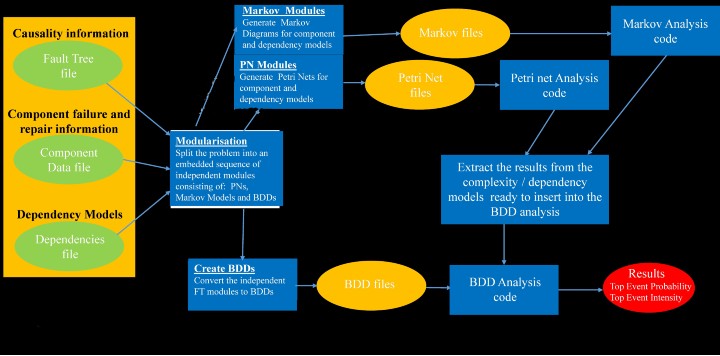Dynamic and Dependent Tree Theory (D2T2 )
Traditional, commonly used, methods for predicting the probability or frequency of system failures in safety critical industries all have limitations in either their ability to accurately represent the system features or in their computational efficiency. These key limitations are detailed below:
Traditional Methodologies
| Methodology | Limitations in Modelling Complex Systems |
|---|
| Fault Tree Analysis (Kinetic Tree Theory) |
Assumes all basic events occur independently e.g. the failure of one component does not affect the likelihood of another component failing. Dependencies introduced by standby systems, common cause failures, or maintenance strategies cannot be adequately represented.
Assumes that components experience constant failure and repair rates
Has to "simplify" the analysis when the fault tree structure becomes too large or complex by identifying only the significant minimal cut sets. An approximate quantification of the system performance then results.
|
| Petri nets and Monte Carlo Simulation |
These methods can accurately represent all systems design, maintenance and operational features. However, to model the whole system, especially when system failures are rare, such simulation based solutions can require huge processing capabilities to reach a statistically significant result. |
| Markov Models |
Can experience “state space explosion” - the model becomes enormous, even for moderately sized systems analysis. Constant transition rates between states also limits its ability to represent maintenance processes (which are not random) or wear out. |
| Dynamic Fault Trees |
Do retain the fault tree structure as a base, and can incorporate dependency types and dynamic features into the framework. However, it cannot cope with dependencies between basic events that are topologically distant from each other in the fault tree structure.
|
It is clear from this that existing methods cannot solve the current and emerging problems facing modern industrial system safety analysis.
The NxGen Project proposes a new fault tree analysis framework - Dynamic and Dependent Tree Theory (D2T2) which can overcome the restrictions and limitations of the traditional methods. Whilst retaining the fault tree structure to express the causality of the system failure, the internal calculation method is updated by exploiting features of Binary Decision Diagrams, Stochastic Petri Nets and Markov methods.
The D2T2 framework offers a practical generalised solution, with the following objectives:
| 1 |
To enable component failure and repair times to be represented by any probability distribution. |
| 2 |
To incorporate the ability for dependencies of any type (due to system structure, operation or maintenance) to be accommodated between components or sub-systems. |
| 3 |
To facilitate the representation of complex maintenance processes to represent the sophisticated asset management strategies employed on modern systems. |
| 4 |
To permit dynamics in the forms of event sequences to contribute to the system failure logic |
A key point is the retention of the fault tree structure, which is familiar to engineers and lends itself to visualisation of the system failure causes. This also facilitates transparency, peer review, and assessment by regulators, and enables fault tree models evolved over many years to be upwardly compatible with D2T2
A more detailed explanation of the new methodology, and a demonstration of its application, can be found in the outputs below.
Tutorial:
Next Generation Fault Tree Analysis Methods (D2T2 - Dynamic and Dependent Tree Theory)
(access slides) (access text)

Figure 1. The D2T2 solution process